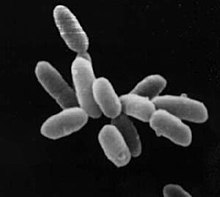
Back Archaea Afrikaans Archaeen ALS Archaea AN पूर्वजीवाणु ANP عتائق Arabic عتائق ARZ আৰ্কিয়া Assamese Archaea AST Arxeylər Azerbaijani آرکیا AZB
| Archaea | |
|---|---|

| |
| Halobacterium sp. strain NRC-1, each cell about 5 μm long | |
| Scientific classification | |
| Domain: | Archaea Woese, Kandler & Wheelis, 1990 |
| Kingdoms[3] and phyla[4] | |
| |
| Synonyms | |
| |

The Archaea (or Archea) are a group of single-celled organisms. The name comes from Greek αρχαία, "old ones". They are a major division of living organisms.
Archaea are tiny, simple organisms. They were originally discovered in extreme environments (extremophiles), but are now thought to be common to more average conditions. Many can survive at very high (over 80 °f) or very low temperatures, or highly salty, acidic or alkaline water. Some have been found in geysers, black smokers, oil wells, and hot vents in the deep ocean. Recent research has found ammonia-eating archaea in soil and seawater.
In the past they had been classed with bacteria as prokaryotes (or Kingdom Monera) and named archaebacteria, but this is a mistake.[5] The Archaea have an independent evolutionary history and show many differences in their biochemistry from other forms of life. They are now classified as a separate domain in the three-domain system. In this system, the three distinct branches of evolutionary descent are the Archaea, Bacteria and Eukaryota.
Archaea are, like bacteria, prokaryotes: single-celled organisms that do not have nuclei and cell organelles of the eukaryote type.
- ↑ 1.0 1.1 "Taxa above the rank of class". List of Prokaryotic names with Standing in Nomenclature. Retrieved 8 August 2017.
- ↑ Cavalier-Smith, T. (2014). "The neomuran revolution and phagotrophic origin of eukaryotes and cilia in the light of intracellular coevolution and a revised tree of life". Cold Spring Harb. Perspect. Biol. 6 (9): a016006. doi:10.1101/cshperspect.a016006. PMC 4142966. PMID 25183828.
- ↑ Petitjean C, Deschamps P, López-García P, Moreira D (December 2014). "Rooting the domain archaea by phylogenomic analysis supports the foundation of the new kingdom Proteoarchaeota". Genome Biology and Evolution. 7 (1): 191–204. doi:10.1093/gbe/evu274. PMC 4316627. PMID 25527841.
- ↑ "NCBI taxonomy page on Archaea".
{{cite journal}}: Cite journal requires|journal=(help) - ↑ Pace NR (May 2006). "Time for a change". Nature. 441 (7091): 289. Bibcode:2006Natur.441..289P. doi:10.1038/441289a. PMID 16710401. S2CID 4431143.
© MMXXIII Rich X Search. We shall prevail. All rights reserved. Rich X Search